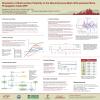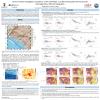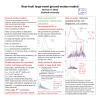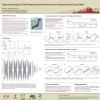Poster #228, Ground Motions
Full Waveform Seismic Tomography for geophysical velocity model in South Island region, New Zealand based on Adjoint-Wavefield method
Poster Image:

Poster Presentation
2020 SCEC Annual Meeting, Poster #228, SCEC Contribution #10433 VIEW PDF
In this poster we present the results of applying Full Waveform Tomography (FWT), based on the Adjoint-Wavefield (AW) method, to iteratively invert a 3-D geophysical velocity model for the South Island region (Eberhart-Phillips et al., 2010). The seismic wave fields were generated using numerical solution of the 3-D visco-elastodynamic equations (Graves, 1996) with sources represented as point sources, and through the AW method, gradients of model parameters (compressional and shear wave velocity) were computed by implementing the cross-adjoint of forward and backward wavefields. The misfit measure is a frequency-dependent multi-taper travel-time difference using a period range 10–40s. The main computational cost relates to the computation of the gradient of the misfit function for each event (event kernel). The event kernels are then combined by summing, preconditioning, and smoothening; and using the L-BFGS/ parabola fitting line search algorithms to obtain the model update.
To verify the method’s performance, a synthetic study using 16 events and 25 stations equally distributed shows good convergence of the inverted velocity models to the given true model (with checkerboard perturbations). For real data analysis, simulation-to-observation misfit measurements at frequencies from 0.025 - 0.1 Hz, based on 13 sources and 10 seismic broad band stations, in the Northern part of the South Island region, New Zealand were used in the first stage of our inversion. 14 more events were included at the second inversion stage. Each inversion stage was run for up to 10 iterations or if no appreciable misfit reduction occurs. After the first stage of inversion runs, the simulated seismograms computed using our final velocity model show a significant reduction of the misfit. The histograms of the relative waveform misfit and travel time difference between observed and simulated data for a fixed set of windows also indicate the improvement of the inverted velocity model toward the true model. A set of ground motion validation tests was also performed which shows the improvement of the ground motion prediction.
To verify the method’s performance, a synthetic study using 16 events and 25 stations equally distributed shows good convergence of the inverted velocity models to the given true model (with checkerboard perturbations). For real data analysis, simulation-to-observation misfit measurements at frequencies from 0.025 - 0.1 Hz, based on 13 sources and 10 seismic broad band stations, in the Northern part of the South Island region, New Zealand were used in the first stage of our inversion. 14 more events were included at the second inversion stage. Each inversion stage was run for up to 10 iterations or if no appreciable misfit reduction occurs. After the first stage of inversion runs, the simulated seismograms computed using our final velocity model show a significant reduction of the misfit. The histograms of the relative waveform misfit and travel time difference between observed and simulated data for a fixed set of windows also indicate the improvement of the inverted velocity model toward the true model. A set of ground motion validation tests was also performed which shows the improvement of the ground motion prediction.




















































